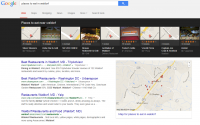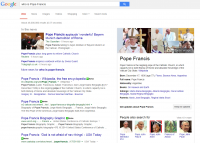Make sure to read my blog post from Monday about eye tracking studies as this will help you to understand this information.
As Google works hard to keep users on the search results page longer in order to not lose relevance but also to have the opportunity to serve more advertising and make more money, it becomes harder for business owners to get Google.com searchers into their website to see their full range of services, products, and marketing information.
How is Google keeping searchers all to themselves?
The Knowledge Graph
Although you may not know the name of this feature, surely you have seen it in action when you have done a search recently. The image at the top of this post is of one such knowledge graph boxes that pop up on a search I did recently on Pope Francis. Google chooses when to show this additional content which is gleaned from a variety of sources. In many cases the information is supplied by Wikipedia or other relatively authoritative websites. One will not typically find content from business websites but rather news, Wikipedia, .org, Google images, or authoritative sites supplying the content found in the knowledge graph.
In some cases the knowledge graph may show results from your own Google+ contacts – another reason to start building your empire on Google+ to benefit your own business.
In many cases the reader simple gets the information they want from the knowledge graph and does not even leave Google.com for more information.

The Carousel
Just like you’ve seen the knowledge graph, you’ve seen the Google Carousel as well. Typically this black background slide show pops up for restaurants and hotels when you query a specific location.
By interacting with the ribbon you can see images pulled from the business’ Google My Business page, get directions, read reviews and even click into their website. Typically Google will preferentially show the business’ Google My Business (aka Google Places page) in the top organic spot in the organic search results with a map and a knowledge graph on the right. The actual business website may or may not appear at all in the organic results in the first ten results.
The Quest for Organic Placement Just Got Harder
Based on all these features that Google is loading into the search results page, it is getting harder and harder for a business owner to appear in the organic results. Just another reason why so many businesses are now flooding into Google AdWords in an effort to appear on the first page of search results.
All these changes are great for Google, making their search engine results page becoming a destination into itself and making it much more difficult for a business to garner traffic organically.
If there is one important take away from this information it is that a Google My Business page is now key for your business in order to be competitive and to potentially appear in the “local” knowledge graph and in the carousel and location specific results. With Google showing fewer website results you’ve got to use Google’s own products to leverage your exposure for desktop and mobile searches.

